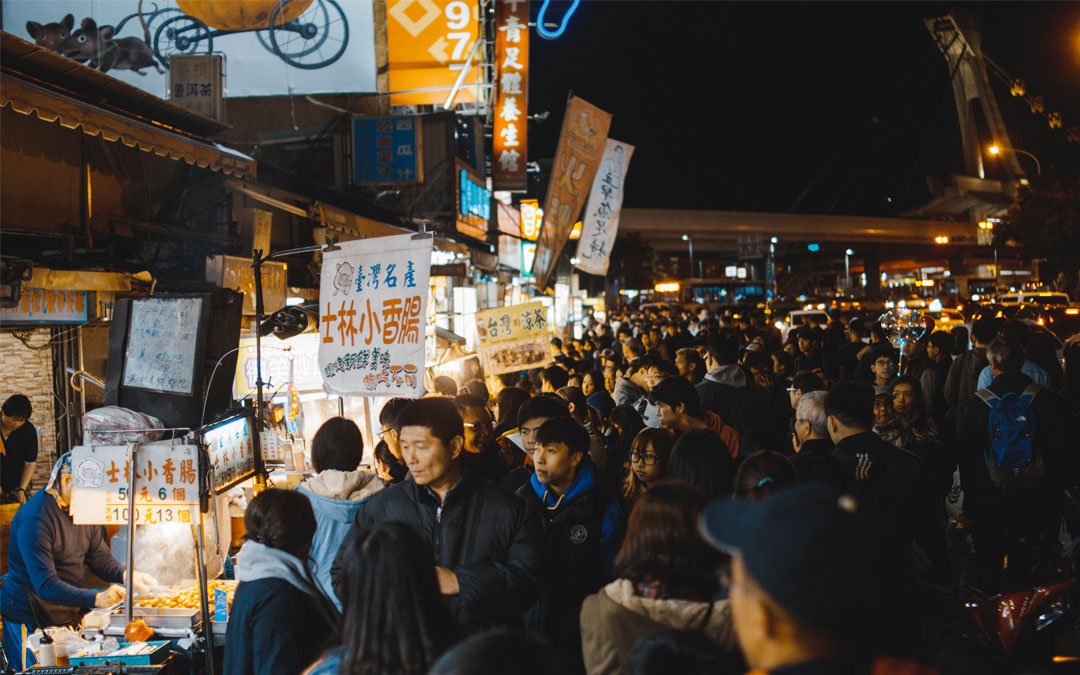If a tree falls in a forest and there is no one to hear it, does it really make a sound? If you visit Taiwan and omit a stop at one of its many famed night markets, have you really visited Taiwan?
No, you haven’t. (That was not a rhetorical question.) There is so much you can learn about a country’s identity from its food, and Taiwan’s night markets are the perfect places to indulge in some gluttony while telling yourself you’re pursuing a cultural activity.
Visit these 5 Taipei night markets for some snacks unique to them, and experience traditional culinary traditions at the same time.
1. Shilin Night Market
Synonymous with the fried chicken cutlet we get in Singapore, Shilin Night Market actually offers a much wider variety of street food, all of which offer a more unique destination for your taste buds.
Try, for instance, some pan fried buns at Zhong Former Shanghai Pan-Fried Bun (鍾家原上海生煎包), available at NTD12 each. Each delicate morsel, like a pan-fried xiao long bao, is bursting with soupy broth, so be careful not to scald your tongue when sinking your teeth into its translucent skin.
Oyster omelette, with its savoury gelatinous texture and briny ocean-fresh oysters, is a perennial local favourite, and not to be missed (about NTD60 at various stalls) as well. It’s slightly sweeter and springier than the Singaporean version, but comes with the same lip-smackingly spicy sauce.
Browse and patronise any stall that appeals to you, or simply join the one with the longest queue.
Getting there: Take the Red Line 2 to Jiantan Station (劍潭), not Shilin Station. After leaving Exit 1, cross the street to the left and the night market will be in sight.
2. Raohe Night Market
Please do not visit Raohe Night Market without eating Fu Zhou Shi Zu Pepper Buns (福州世祖胡椒饼). This is not a fire drill. I repeat, do not visit Raohe Night Market without eating Fu Zhou Shi Zu Pepper Buns.
Its premise sounds deceptively simple: a wheat-based bun stuffed with marinated pork and spring onions, costing NTD50 each. But it is the pork bun elevated to gourmet standards. Each bite rewards you with a chunk of pork, its porcine juices soaking the bun, still crispy, as the freshness of the spring onions cuts through any heaviness.
The Michelin inspectors, heeding my advice, have awarded the stall a Michelin Bib Gourmand designation. They were wise not to ignore me, so you probably shouldn’t, either.
Getting there: Take the Green Line 3 to the terminal station Songshan (松山). Leave the station from exit 5. You will spot the night market entrance across the street, next to the temple.
3. Ningxia Market
Though smaller in size and variety than Shilin Night Market or Raohe Night Market, Ningxia Night Market offers one unique advantage over the both of them: it’s entirely sheltered! No inclement weather will present an impediment to indulgence.
That is not to say the food at Ningxia Night Market does not stand up on its own. Huan Ji Sesame Chicken (環記麻油雞) sells a bowl of mee sua doused in an aromatic sesame broth, topped with chunky chicken pieces. Established in 1941, the shop’s enduring legacy tells us good food is timeless.
If you’re not saturated with sesame after that, head to Lin Ji Mochi (林記燒麻糬) for some dessert. The stall offers its irresistibly bouncy mochi (NTD40 for two) dusted with ground peanuts and black sesame seeds.
I tell myself that chewing the mochi is a form of exercise, but feel free to disregard my wisdom.
Getting there: Getting there: Take the Red Line 2 to Shuanglian (雙連) station. At Exit 1, take a left onto Minsheng West Road (民生西路), heading west. Walk for about 6-8 mins, and the market will be on your left.
4. Miaokou Night Market
With a name that translates literally to “mouth of the temple”, how would we dare to defy its religious edict and not put food into our mouth?
Miaokou Night Market is located at the port city of Keelung, just an hour’s ride away from Taipei by train. When at a port city, it would be foolish not to have seafood, so head straight for one of the many seafood stalls at Miaokou Night Market hawking their catch of the day. You pick the seafood you want, how you want it cooked, find a seat, and eat. Simple, but delicious.
Finish this fresh feast with mostly Pao Pao Shaved Ice (泡泡冰), a cross between ice cream, sorbet, and shaved iced, made from freshly pulped fruits. This fine icy dessert is traditionally mixed by hand to achieve the “bubbling” effect that gives it its characteristic lightness; after eating it, I feel light as a bubble.
Getting there: At Taipei Main Station, take a Local Train (區間車) on Taiwan Railways to Keelung Station. Each ticket costs NT$41; trains leave every 15-20 minutes, all day.
5. Lehua Night Market
Lehua Night Market is not a common stop on many travellers’ itineraries. It’s slightly further away from the typical attractions near the city centre, and doesn’t boast of any famous, must-try stalls.
Indeed, it’s on this list for an entirely different reason: it’s the night market which offers the biggest proportion of foreign food.
To understand the soul of a country and its gastronomic culture, we not only have to try its indigenous cuisine, but also its interpretations of other food. Hence, Lehua Night Market. Go there not to try the typical Taiwanese snacks of fried chicken cutlet or oyster omelette, but Hong Kong curry fish balls, Turkish kebabs, Japanese sushi.
Lehua Night Market is also the first night market to be eco-friendly, so be sure to bring along your own reusable bags and cutlery!
Getting there: Take the Orange Line 4 and alight at Dingxi Station (頂溪). Turn left onto Yonghe Road, Section 1 (永和路一段) from Exit 1, and continue walking south for around 8-10 minutes. The night market will be on the right.




